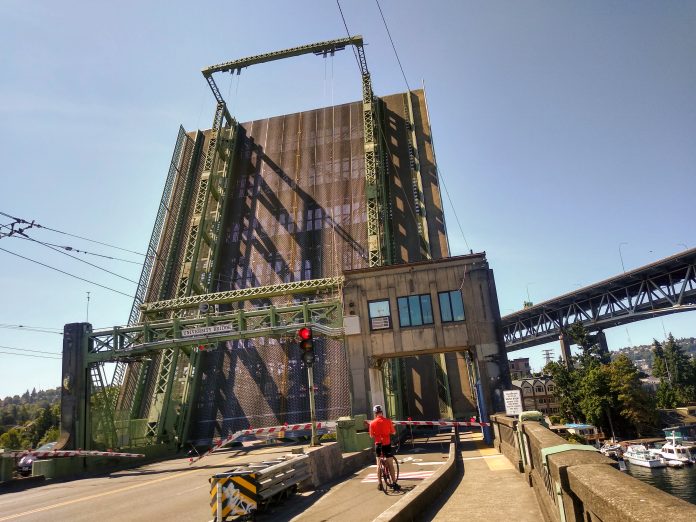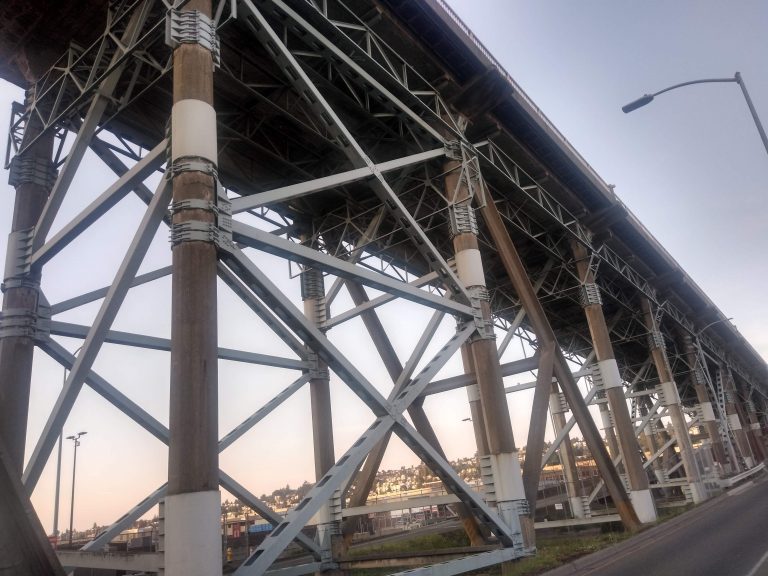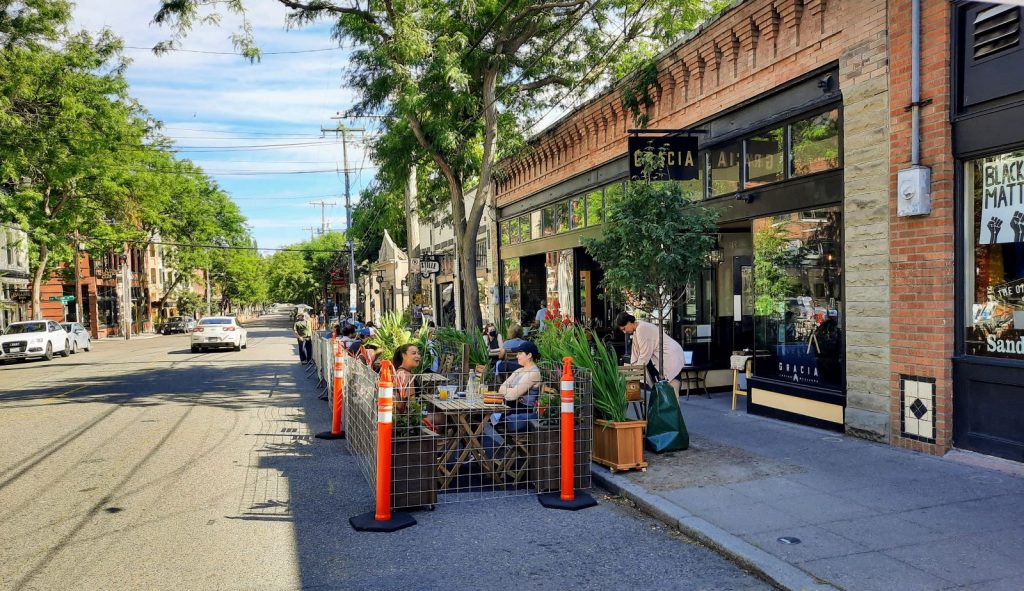
A proposal for the City of Seattle to issue bonds to pay for maintenance on several key bridges has been put back on the table by Councilmember Alex Pedersen (District 4) and will be discussed today at the city council’s select budget committee meeting. Pedersen’s proposal, which has the backing of Councilmembers Debora Juarez (District 5) and Andrew Lewis (District 7) at this point, would issue $100 million in bonds to be repaid over a 20-year period. Pedersen eyed the idea of issuing bonds to pay for bridge maintenance earlier this year, but unlike the earlier proposal this amendment doesn’t appear to divert a revenue source that the Seattle Department of Transportation (SDOT) was proposing to dedicate to making the city’s streets safer.
According to city council’s central staff, assuming a 4% rate of interest, the $100 million bond issue could cost the city $155 million including interest and the cost of issuing the bonds over that full 20 years. It’s possible, however, that a lower interest rate could end up being secured by the City, leading to a lower full payment amount.
The majority ($61 million) of that funding would go toward seismic upgrades for the Ballard and Fremont bridges that were supposed to be funded via the Move Seattle levy but were found more expensive than the budget could support after additional analysis.
$23.5 million would go to structural rehabilitation on the University Bridge, Magnolia Bridge, Fauntleroy Expressway, and for a hydraulic overhaul of the Spokane Street swing bridge. An additional $6 million would go to additional planning efforts for the Magnolia Bridge’s replacement, while remaining funds would be dedicated to overall bridge maintenance.
It’s important to note that seismic upgrades to bridges are separate from their ongoing maintenance costs. With the seismic upgrades to the Fremont and Ballard Bridges checked off the list, earthquake retrofits that remain unfunded would total around $600 million, including pricey improvements needed on the 1st Avenue S and 4th Avenue S bridges over the Argo train yard and on the 4th Avenue S bridge near King Street Station.

As signaled in past weeks, Councilmember Lewis is also proposing to increase the City’s commercial parking tax, which would take effect mid-year and generate an expected $3.2 million in 2022 and $6.4 million in future years. 45% of the revenue raised is proposed to be dedicated to bridge maintenance, 45% to Vision Zero projects, and the remaining 10% to a new proposed capital project called “District Traffic Safety.”
Described as “pedestrian and bicycle safety improvements, traffic calming, and neighborhood enhancements that support Vision Zero and community use of the right-of-way”, it is unclear exactly how District Traffic Safety projects would be different than Vision Zero projects, but it looks like they would be specific projects approved by the city councilmembers for their own districts opening up the possibility that councilmembers could prioritize funding in a way that de-emphasizes citywide safety data in favor of vocal communities asking for traffic calming.
It remains to be seen just how Lewis’s proposal to use the commercial parking tax to pay for bridge maintenance would mesh with Pedersen’s bonding proposal; a better idea should emerge as the councilmembers discuss the proposals during the budget committee meeting.
Proposed Council Additions
Every year there is a long list of transportation items that councilmembers would like to see funded. Since the council doesn’t generally like to go in and start cutting projects to fund their own priorities, getting an amendment request into the budget generally requires the Chair of the budget committee to find new revenue, but there are exceptions. Below is a list of all the amendments being proposed, that were able to secure at least two additional co-sponsors, with the primary sponsor listed after each one. Additional councilmembers may decide to add their names, but that support is not always the main reason why a budget amendment lives or dies. When the balancing package is released on November 10, we’ll see which amendments budget chair Teresa Mosqueda was able to fit in.
- $3.75 million for additional Home Zones, which create pedestrian friendly neighborhood streets. Home Zones, as they have been constructed in Seattle so far, consist of traffic calming measures deployed over an area wider than just one corridor. Home Zones are moving forward in Georgetown, South Park, Broadview, and Highland Park; 18 neighborhoods were found to be good fits for Home Zones but not funded. SDOT considers a basic Home Zone to cost approximately $200,000 per neighborhood. (Morales)
- $2 million for new sidewalks in District 2. The southeast quadrant of the city has not seen a proportional share of new permanent sidewalks during the life of the Move Seattle levy. This would require SDOT construct new sidewalks on 20th Avenue S, S Othello Streets, streets around Rainier View Elementary and elsewhere in D2. (Morales)
- $655,000 for the Market to MOHAI project. The initial phase of this project added wayfinding and markers with historical information to this corridor in Belltown and South Lake Union and was primarily funded through private dollars. This public funding would pay for eleven lights along Western Avenue and Bell Street. (Lewis)
- $500,000 for public space amenities on the site of the former Battery Street tunnel, which is being eyed as the site of a Downtown school. Those amenities “include, but are not limited to: a deck, benches and tables, lighting, waste receptacles, sidewalk improvements, and physical improvements to facilitate the hosting of food trucks on site.” (Lewis)

- $270,000 to continue design on Ballard Avenue NE pedestrian and streetscape improvements incorporating the current café seating configuration. The council previously allocated $50,000 for this project, and the additional funding would get the project to 30% design. (Strauss)
- $200,000 to develop design concepts for potential changes to Lake Washington Boulevard, after overwhelming community support for more car-free space there. (Morales)
- $150,000 in added funding as well as a requirement that SDOT spend no less than $500,000 on pedestrian and bicycle safety on the I-5 bridge at NE 45th Street. The Urbanist covered this amendment more in detail yesterday. (Pedersen)
- $100,000 for a pedestrian safety study on NE Northgate Way. (Juarez)
- $25,000 to boost the proposed budget for adaptive cycling rentals for people with disabilities through the Outdoors for All foundation by 50%. (Strauss)
- We’re also hearing that an amendment will be walked on, sponsored by Councilmember Pedersen and Herbold, that would redirect the $2.4 million that Mayor Durkan has allocated in the budget to move the Center City Connector forward. Those councilmembers don’t appear to have been able to find a third sponsor, but they may try and make their case to kill the streetcar project.
Requests for Reports
Councilmembers are also requesting a number of reports from SDOT through the budget process. Since this doesn’t involve finding revenue to offset, there’s a much higher likelihood that other members will sign on and these amendments will be adopted.
- A report on how to improve pedestrian and bicycle safety along MLK Jr Way S from Rainier Avenue S to S Henderson Street. SDOT has already started the planning process to study the feasibility of adding a protected bike lane to this stretch that would connect to the bike lane that SDOT will be constructing north of Rainier next year. (Morales)
- A report on how SDOT could improve the S King Street neighborhood greenway, a key connection between 12th Avenue S and 5th Avenue S protected bike lanes but lacking significant traffic calming infrastructure. (Morales)
- A report on the feasibility of the city-run e-bike rental service, which is a service that is available in cities like Toronto (and soon to be Vancouver, B.C.) with Zygg. (Morales)
- A report on SDOT’s progress on systemic analysis of safety around people walking, biking, and rolling, following the last update to the department’s Bike & Pedestrian Safety Analysis (BPSA). Of note: “The Council requests that the report explain how community-raised safety concerns are encouraged to be reported and evaluated by SDOT, especially for community members who may choose not to report traffic safety incidents to the Seattle Police Department due to concerns with police interaction.” (Morales)
- A report on the impact of over-weight vehicles on Seattle’s streets and bridges. (Pedersen)
Related is an attempt by several councilmembers to impose a proviso, or legislative restrictions, on the Seattle Transportation Plan currently in development. Council President González is leading the effort to ensure that this effort doesn’t lead to backsliding on the city’s adopted plans, as initial information reported by The Urbanist suggests is likely. This proviso would prevent SDOT from spending more than $1 million on the plan until it has shown a work plan and community outreach plan, presumably at a public city council committee meeting.
Today at 10am we’ll hear more details about all of these proposed amendments. These changes all come on top of the Mayor Durkan’s proposed transportation budget, with other proposals to bolster Move Seattle levy deliverable goals also coming down the pike.
Ryan Packer has been writing for The Urbanist since 2015, and currently reports full-time as Contributing Editor. Their beats are transportation, land use, public space, traffic safety, and obscure community meetings. Packer has also reported for other regional outlets including BikePortland, Seattle Met, and PubliCola. They live in the Capitol Hill neighborhood of Seattle.

